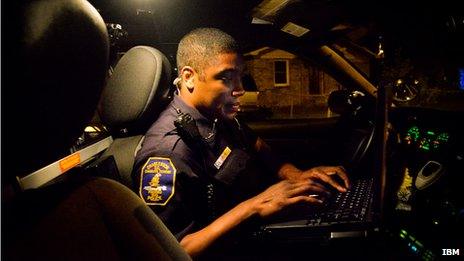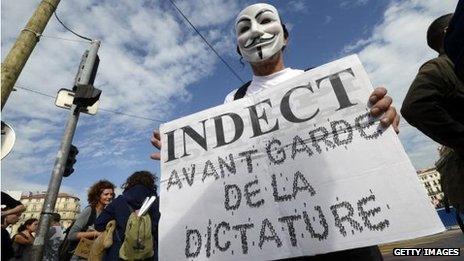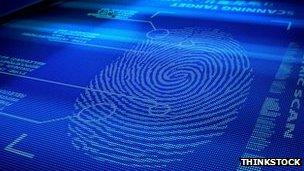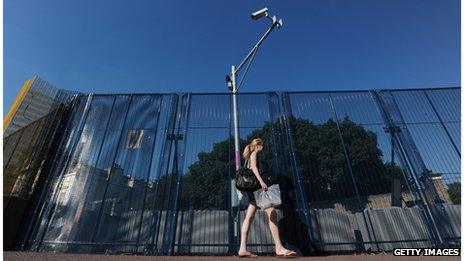Predicting crime - a step towards a safer world?
- Published

Several police departments in the US are now using the IBM predictive analytics technology
Want to catch a criminal? Prevent a crime? Technology may help - by predicting where crimes might occur.
A police officer glances at a screen displaying a city map - and one area suddenly starts flashing red.
Seconds later, the department receives data about an assault that is likely to happen there in the next few hours.
Patrols get deployed - just in time to stop the crime from happening. No-one gets hurt.
It might sound like a scenario straight out of the science-fiction film Minority Report, but predictive analytics technology to fight crime already exists.
Researchers are working on software that tries to determine which city areas are prone to crime.
The computer program analyses police activities, aggregating huge amounts of information, from past and present crime records to real-time data from police patrols.

The EU Indect initiative has sparked protests around Europe
It then dots a city map with zones where an offence is likely to occur, even detailing the possible nature of future crimes.
There have been a number of predictive crime mapping pilot projects in Britain and the United States, and chief constable Mike Barton from the UK Association of Chief Police Officers calls them "the next generation of intelligence-led policing".
"[Such] technology can help us to anticipate where crime will occur, and in particular, where it is displaced as a result of police activity," he says.
"This has clear benefits when it comes to directing resources effectively and in reducing repeat victimisation."
'Hotspots'
One predictive analytics developer is electronics giant IBM.

Technology is helping police to move towards a Minority Report-style future
At a recent conference at the company's lab near Winchester in the UK, the firm suggested that over the past seven years its technology had helped reduce crime in Memphis, Tennessee, by more than 30%.
"The software helps police to recognise patterns and determine a city's criminal 'hotspots' - to then patrol them more than others, deploy traffic enforcement and launch targeted operations," says IBM's Ron Fellows.
Besides Memphis, the technology is also being used in several other cities in the UK and US.
Another company working on predictive analytics is start-up PredPol, based in Los Angeles, California.
Its software has been tested by the Los Angeles Police Department since 2011. Again, the firm claims impressive results.
UK privacy and civil liberties campaign group Big Brother Watch welcomes the predictive analytics technology.
"This kind of approach, using crime data and pursuing the 'broken windows' strategy, is far more effective at reducing crime and improving public safety... than the Home Office's current proposal to trawl everyone's communications and hope you get lucky," says Nick Pickles, the organisation's director.

In the UK, the Home Office thinks CCTV is an effective way to fight crime
"Sadly in Britain we've spent hundreds of millions of pounds on CCTV cameras despite the evidence showing it is a largely ineffective way of cutting crime and in too many towns there are cameras on every corner but people rarely see a police officer."
Triggering alarms
But the Home Office argues that video surveillance efforts to fight and prevent crime are paying off.
And Britain is not alone in dotting the landscape with CCTV cameras - a study by researcher RNCOS, external suggests that by the end of 2014, about $23.5bn (£14bn) a year will be spent on new cameras globally.
Now, there are plans in Europe to pair existing video surveillance systems with predictive technology.
A European Union research project, Indect, aims to "improve the way to analyse the existing images of video surveillance cameras… to identify images that allow the detection of dangerous or criminal behaviour".
The goal is for computers to sift through huge amounts of real-time video and flag up potential disturbances.
It could be, for instance, a huge crowd at a concert or a sports event where people start throwing objects.
Marco Malacarne oversees Indect for the European Commission. He says the initiative could help address "a central problem of police forces in the EU: the difficulty to efficiently analyse the images provided by video surveillance.
"In times of crisis or attacks, it is nearly impossible for the police to monitor all the information provided by today's surveillance technologies.
"The most explicit example for this was the London bombing in 2005 which led to the deaths of 52 innocent people.
"The Metropolitan Police had to withdraw hundreds of police from the streets and put them in front of screens to identify the attackers and their background."
The project is still in the research phase, but it has already sparked worldwide protests, organised by hacktivist group Anonymous.
People wearing the organisation's trademark white masks took to the streets in October, campaigning against Indect, and a similar, already operational, video surveillance system in the United States by a software company Trapwire.
The firm collects data from CCTV cameras and number plate readers in an attempt to forecast acts of terrorism.
Big Brother Watch says such projects "demonstrate a dangerously heavy-handed attitude towards the public, with an assumption that citizens are presumed guilty until a computer decides the way they are walking is not worthy of further investigation".
But Mr Malacarne says there are no plans to have a centralised European video surveillance system - it will be up to member states to decide how they improve the use of CCTV to tackle crime.
Whatever methods police use, Minority Report-style policing seems to be moving closer.
- Published3 October 2012
- Published14 August 2012